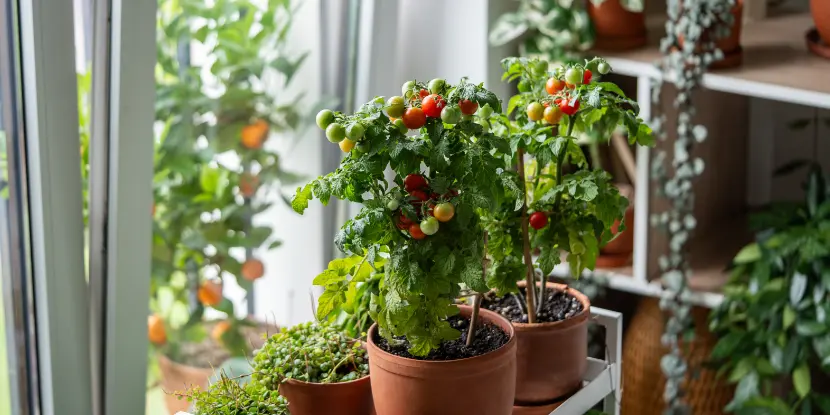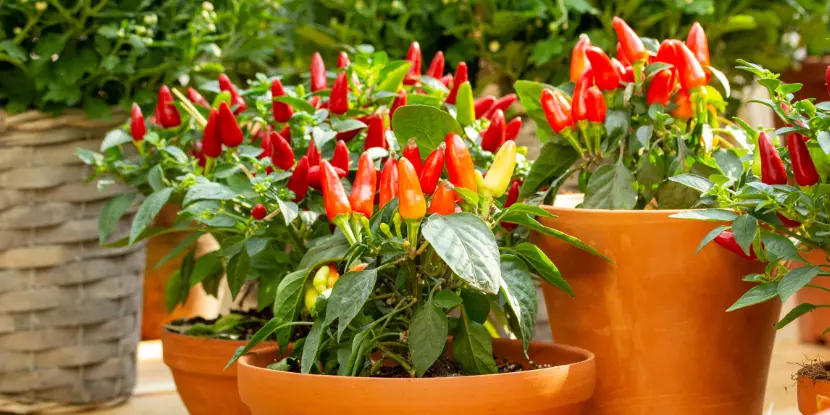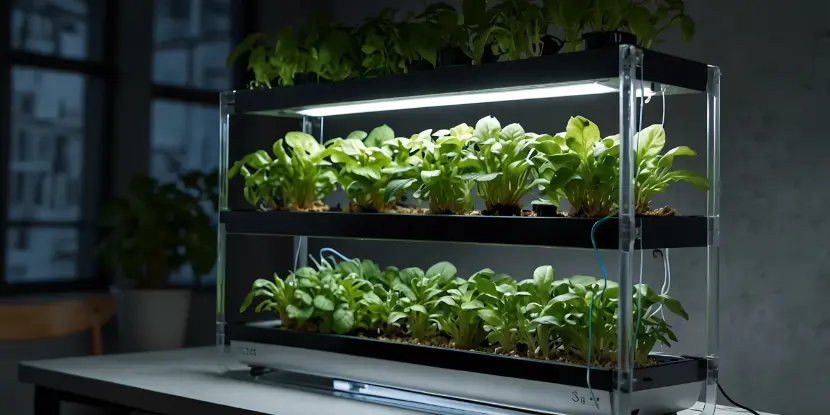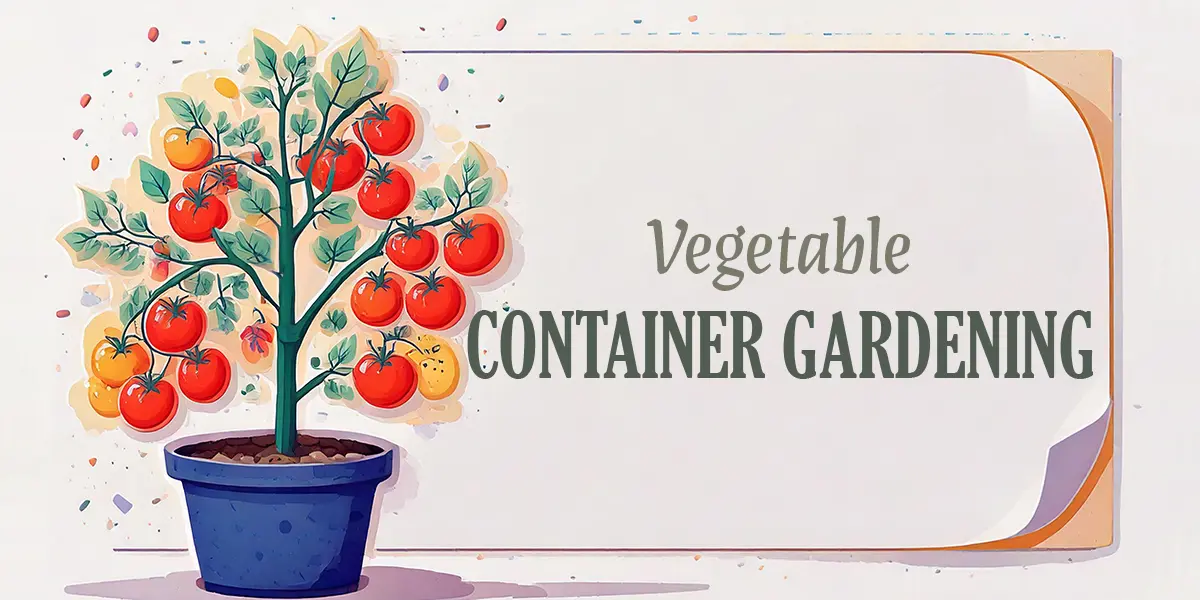In Green Acres, Eddie Albert abandoned the big city to try farming in a three-piece suit. How he and his socialite wife managed to survive is one of television’s great mysteries.
He could have stayed in New York and built a container garden instead. Maybe not for corn, but certainly for tomatoes, peppers, lettuce, and all the other veggies that make a great salad.
Container gardening is a godsend for growers with limited space. A well-organized container garden will fit on a porch, a patio, a wall, or even under a grow lamp in the darkest room of your apartment.
What Is Container Gardening?
Container gardening is exactly what it sounds like — growing plants in containers rather than the ground. It lets you cultivate a variety of plants, from vegetables and fruits to flowers and shrubs, all within the confines of your apartment or small outdoor areas.
This method is space-efficient and flexible. You can move containers around to catch the best sunlight, switch things up for aesthetics, or even bring your garden indoors during colder months.
The key to successful container gardening lies in choosing the right plants and giving them the care they need.

Cherry tomatoes growing near a sunny window.
Benefits of a Container Vegetable Garden
Container gardening holds several advantages over the standard garden plot.
- As mentioned, it allows anyone with limited space to grow their own produce.
- You can keep container gardens at a comfortable height. They’re accessible to people with physical limitations or disabilities.
- Container gardens are less susceptible to common pests. They’re raised off the ground and can easily be moved away from potential infestations.
- You have more control over soil quality and can customize it for different plants. You also have the freedom to move containers around as needed.
- A well-designed container garden can beautify a space and attract birds and butterflies.
Best Vegetables for Container Gardening
Start with easy-to-grow vegetables offering bountiful harvests. These include:
- Tomatoes: Look for compact varieties that thrive in containers, such as cherry or patio tomatoes.
- Peppers: Choose smaller varieties like Jalapeños or mini bell peppers.
- Leafy greens: Lettuce, spinach, and kale all do well in containers and can be harvested multiple times throughout the growing season.
- Herbs: Grow your own fresh herbs, like basil, rosemary, and mint, to add flavor to your cooking.
- Root vegetables: Carrots, radishes, and beets can flourish in deeper pots with loose soil.
Always check each vegetable’s growing requirements before planting. Some may need more space or sunlight than others.

Hot peppers growing in clay pots.
Choosing the Right Containers
- Material: Clay, plastic, wood, or metal pots have pros and cons. Clay pots allow for better drainage but can dry out quickly, while plastic pots retain moisture but may not be as durable. Consider the needs of your plants when choosing a material.
- Size and depth: This will depend on the type of vegetable you’re growing. For example, larger plants like tomatoes or peppers will need deeper pots for root growth.
- Drainage holes: Containers should have proper drainage at the bottom to prevent water from pooling.
- Aesthetics: Don’t be afraid to get creative with your containers! You can repurpose old buckets, cans, or even a shoe organizer for vertical gardening.
Caring for Your Container Vegetable Garden
- Watering: Since containers have less soil than traditional gardens, they dry out faster. Water them regularly but not too much. Measure the moisture level with a finger test — stick your finger in the soil up to the first knuckle. If it feels dry, it’s time to water.
- Fertilizing: Use a balanced fertilizer every 2–3 weeks during the growing season.
- Sunlight: Most vegetables need at least six hours of sunlight a day. Position your containers accordingly.
- Pest control: Regularly inspect your plants for pests and take preventative measures, such as applying natural pest repellents or using companion planting techniques.
Vertical Container Gardening
Vertical gardening is a brilliant solution for urban dwellers with limited horizontal space. You can maximize your garden’s potential without sacrificing floor space. Here’s how to get started:
- Choose climbing or vining plants like peas, pole beans, or cucumbers that naturally grow upward. They can be trained to climb trellises, walls, or fences.
- Invest in vertical garden systems like wall planters, hanging baskets, or tiered plant stands. These structures let you grow multiple plants in a small footprint and transform blank walls into flourishing green spaces.
- Layer and mix different types of plants to create visually appealing arrangements. Mix flowering plants with herbs or trailing vines to add texture and interest.
- Use lightweight pots or fabric planters that are easier to maneuver and move around.

A vertical garden growing indoors.
Hydroponic Container Gardening
Hydroponic gardening involves growing plants in a nutrient-rich water solution instead of soil. This method is gaining popularity due to its space efficiency and ability to produce high yields.
- Plant roots are submerged in a nutrient solution that provides everything they need and allows for faster growth and larger harvests.
- Start with a simple hydroponic system, such as the Kratky method or a deep water culture system. These setups are beginner-friendly and require minimal equipment. You’ll need a container, a water reservoir, a nutrient solution, and a light source.
- Leafy greens, herbs, and small vegetables are ideal for hydroponic gardening. Lettuce, spinach, basil, and mint thrive in hydroponics and can provide fresh produce year-round.
- Monitor and maintain the nutrient levels of your hydroponic system to ensure plant health. Regularly change out the water and add nutrients as needed.

An indoor hydroponic system for vegetables.
Additional Tips
These extra tips will help you get the most out of your container vegetable garden:
- Use organic potting soil for better nutrient absorption and drainage.
- Rotate your crops each season to prevent soil depletion and reduce the risk of pest infestations.
- Consider using self-watering containers or adding a layer of mulch on top of the soil to retain moisture.
- Be aware of temperature changes, as containers can quickly heat up or cool down. Protect your plants from extreme temperatures by moving them to a more suitable spot.
- Regularly prune and harvest your plants to promote growth and prevent overcrowding.
FAQs: Vegetable Container Gardening
Q: Can I grow root vegetables in containers?
Root vegetables like carrots, radishes, and beets can thrive in containers. Choose deep pots and ensure the soil is loose and well-draining to encourage healthy root development.
Q: How often should I water my container plants?
This depends on plant type, container size, and weather conditions. Check the soil’s moisture regularly and water when the top inch feels dry. During hot weather, you may need to water daily.
Q: Can I use any type of soil for container gardening?
Opt for a quality potting mix for container gardening. Potting mix is lightweight, retains moisture well, and provides essential nutrients for plant growth.
Q: Are there certain vegetables better suited for container gardening than others?
Yes, certain vegetables are particularly well-suited for container gardening. Leafy greens like lettuce and spinach and compact plants like herbs, cherry tomatoes, and peppers are ideal choices due to their smaller size and adaptability to confined spaces.
Q: How can I improve drainage in my container garden?
Ensure your containers have holes at the bottom. Before adding soil, you can also place a layer of gravel or small stones at the base of each pot. A high-quality potting mix that includes perlite or vermiculite can further enhance drainage.
Q: Is it possible to grow vegetables indoors using containers?
Yes, many vegetables can be successfully grown indoors in containers. Key requirements include sufficient light from a sunny window or supplemental grow lights and a consistent watering schedule. Indoor conditions make it easy to control temperature and humidity, favoring plant growth.
Q: What should I do if my container plants become root-bound?
A root-bound has filled the container and has nowhere to grow. Carefully remove the plant from its pot, gently loosen the roots, and replant it in a larger container with fresh potting mix.
Q: Can I reuse potting soil from season to season in my containers?
Yes, but it’s important to refresh it. Remove any remaining plant material and mix in new potting mix or compost to replenish nutrients. You may also need to sanitize the soil, using methods like solarization, to eliminate pests or diseases.

